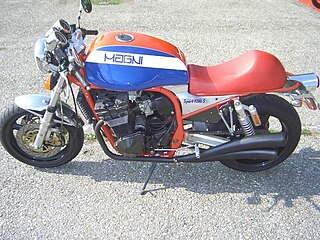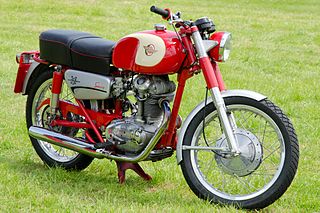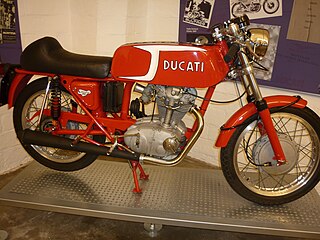
Laverda was an Italian manufacturer of high performance motorcycles. The motorcycles in their day gained a reputation for being robust and innovative.

The Aprilia RS250 is a two-stroke 249 cc (15.2 cu in) sport bike made by the Italian motorcycle manufacturer Aprilia.

A motorcycle frame is a motorcycle's core structure. It supports the engine, provides a location for the steering and rear suspension, and supports the rider and any passenger or luggage. Also attached to the frame are the fuel tank and battery. At the front of the frame is found the steering head tube that holds the pivoting front fork, while at the rear there is a pivot point for the swingarm suspension motion. Some motorcycles include the engine as a load-bearing stressed member; while some other bikes do not use a single frame, but instead have a front and a rear subframe attached to the engine.

The Moto Guzzi Le Mans is a sports motorcycle first manufactured in 1976 by Italian company Moto Guzzi. It was named after the 24-hour motorcycle endurance race at Le Mans in France. The Le Mans designation was first used for an 850 prototype, based on the V7, displayed at Premio Varrone in late 1972.
The Hesketh V1000 is a 992 cc (60.5 cu in) OHC V-twin motorcycle with 4 valves per cylinder. It was originally designed and built by Hesketh Motorcycles in Daventry, Northamptonshire. Sales proved disappointing as the motorcycle was expensive and, at 86 bhp, it was somewhat underpowered given its hefty dry weight of 244 kg (538 lb).

Capriolo, later called Aeromere, was the name of the motorcycle production arm of the Italian aircraft company Aeromere or Aero-Caproni. After World War II, the victorious Allies prohibited wartime aircraft and other military hardware suppliers from remaining in their previous industries, and Aero-Caproni would change its name to Capriolo and become one of several, including Aermacchi, MV Agusta, Vespa and Ducati, that switched to producing motorcycles or scooters. These companies did well until the mid-1960s, when the advent of affordable cars like the Fiat 500 removed the economic barrier that kept many Italians relying on motorcycles for basic transportation. Capriolo was typical of those that could not survive the transformation to a more export-orientated industry, with the US as the most important market. Motorcycle production ran from 1947 or 1948 until 1964.

Magni is an Italian company that builds specialist motorcycles. The company is based in the city of Samarate in the province of Varese. Magni, in addition to building the bikes that bear its name, is also active in the construction of specials to order and a supplier of special parts for the restoration of MV Agusta classic motorcycles.

The Ducati Sebring is a 340 cc (21 cu in) single cylinder bevel drive SOHC motorcycle produced by the Italian manufacturer Ducati from 1965 to 1968. At the time of its introduction it was the largest capacity Ducati machine. Production of the original model ended in 1967 when the 'wide case' Mark 3 was introduced, although just over 200 Sebrings were made in 1968 with the 'wide case' engine. Total production was around 3,500 machines.
The Ducati 239 Mark 3 is a 239 cc (14.6 cu in) single cylinder bevel drive SOHC motorcycle produced by the Italian manufacturer Ducati in limited quantities for the French market in 1974. The French Government has announced that they were to increase VAT on motorcycles of 240 cc and above in 1975. Ducati responded by producing the 239 to take advantage of the lower 20% VAT rate on sub-240 machines. To compensate for the reduced capacity, the engine was tuned to produce more power with a different camshaft, slipper piston, 30 mm carburettor and a different exhaust using a Lafranconi silencer.

The Ducati 125 Scrambler is an on/off road 124 cc (7.6 cu in) single cylinder bevel drive SOHC motorcycle produced by the Italian manufacturer Ducati in 1971 and 1972. Although Ducati had stopped production of the 'narrow case' singles in 1967, the Scrambler used a narrow case engine made by MotoTrans in Spain. The model was not a sales success with less than 200 sold worldwide and was soon taken out of production.

The Ducati 250 24 Horas is a 247 cc (15.1 cu in) single cylinder bevel drive SOHC motorcycle produced by the Spanish manufacturer MotoTrans, who were licensed by Ducati to produce motorcycles under the Ducati brand name. The model was based on the 'narrow case' Ducati 250 and produced in three series from 1966 to 1974. It was named after Ducati's successes in the 24 hours of Montjuïc endurance races. Around 2,000 machines were produced in total.

The Ducati Deluxe is a 247 cc (15.1 cu in) single cylinder bevel drive SOHC motorcycle produced by the Spanish manufacturer MotoTrans, who were licensed by Ducati to produce motorcycles under the Ducati brand name. The model was based on the 'narrow case' Ducati Diana 250 and produced from 1963 to 1973. The Deluxe was, in terms of production numbers, MotoTrans' most successful model.

The Ducati Road 250 is a 247 cc (15.1 cu in) single cylinder bevel drive SOHC motorcycle produced by the Spanish manufacturer MotoTrans, who were licensed by Ducati to produce motorcycles under the Ducati brand name and was produced from 1972 to 1977. The model was intended to be a Spanish domestic market version of the 250 Scrambler, although it was also exported to the US in 1972/3.
The Ducati Road 350 is a 340 cc (21 cu in) single cylinder bevel drive SOHC motorcycle produced by the Spanish manufacturer MotoTrans, who were licensed by Ducati to produce motorcycles under the Ducati brand name and was produced from 1973 to 1976. The model was intended to be for the Spanish domestic market although it was also exported to the US in 1973.
The Ducati Strada is a 249 cc (15.2 cu in) single cylinder bevel drive SOHC motorcycle produced by the Spanish manufacturer MotoTrans, who were licensed by Ducati to produce motorcycles under the Ducati brand name and was produced from 1978 to 1983. The model is based on the 250 'wide case' Ducati singles which the Italian Ducati factory had stopped manufacturing in 1974, but which MotoTrans continued to develop and produce.

The Ducati Forza is a 340 cc (21 cu in) single cylinder bevel drive SOHC motorcycle produced by the Spanish manufacturer MotoTrans, who were licensed by Ducati to produce motorcycles under the Ducati brand name and was produced from 1976 to 1983. The model is based on the 350 'wide case' Ducati singles which the Italian Ducati factory had stopped manufacturing in 1974, but which MotoTrans continued to develop and produce.

The Ducati Vento is a 340 cc (21 cu in) single cylinder bevel drive SOHC motorcycle produced by the Spanish manufacturer MotoTrans, who were licensed by Ducati to produce motorcycles under the Ducati brand name and was produced from 1978 to 1983. The model is based on the 350 'wide case' Ducati singles which the Italian Ducati factory had stopped manufacturing in 1974, but which MotoTrans continued to develop and produce. The machine had café racer styling and was intended to be a successor to the earlier 24 Horas.

The Laverda 750 is a 744 cc (45.4 cu in) air cooled SOHC 4 stroke parallel twin motorcycle produced by the Italian manufacturer Laverda from 1968 to 1976. Developed from the company's 650, the engine's design drew heavily from the Honda CB77. Around 18,000 machines were produced.

The Laverda 750SFC is a hand-built 744 cc (45.4 cu in) air cooled SOHC 4 stroke parallel twin production racing motorcycle produced by the Italian manufacturer Laverda from 1971-1976. It was developed from the company's 750SF and drew from the racers used at the 1970 Bol d'Or. Finished in orange with a distinctive half-fairing, the machine was made in batches, with each batch identified by the frame number range. In total 549 SFCs were manufactured.
The Laverda 200 Bicilindrico is a 199.5 cc (12.17 cu in) air cooled ohv 4 stroke parallel twin motorcycle produced by the Italian manufacturer Laverda from 1962 to 1976. It was the company's first twin machine and the time of introduction it was Laverda's largest displacement model. Around 4,500 machines were produced, 2,000 of which were sold on the home market. Most of the remainder were exported to the UK and US as the 200 Gemini. The 14 year production run made it one of Laverda's longest running models.
















